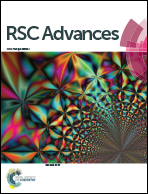The healing of N-vacancy in boron nitride nanotube by using NO and NO2 molecules: a density functional theoretical study
Abstract
Defect healing in boron nitride nanotube (BNNT) would be very helpful for potential applications in various devices. In the present study, density functional theory methods have been used to study the adsorption of NO and NO2 molecules on the N-vacancy defect in BNNT. Both healing processes mainly undergo three evolution steps: (i) the first-step chemisorption of NO or NO2 onto the N-vacancy site in BNNT; (ii) the combination of the N atom of the molecule with the N-vacancy in BNNT, accompanied by the formation of B–O–N epoxy structures; and (iii) the reduction of the oxidized BNNT by sequential exposure to NO molecules with the formation of NO2 and perfect BNNT. In both healing processes, the removal of the last O atom on BNNT is found to be the rate-limiting step, for which the energy barrier decreases with an increase of BNNT diameter, i.e., 0.82 eV in (8, 0) BNNT, 0.54 eV in (12, 0) BNNT and 0.41 eV in hexagonal BN (h-BN), indicating the easy healing of the N-vacancy in BNNT with large diameters and h-BN by NO and NO2 molecules. Moreover, a molecular dynamics simulation further confirms the healing process of the N-vacancy in h-BN by NO at room temperature. Our study will be helpful not only in the purification of BNNT/h-BN, but also in the removal of NO and NO2 gases.


 Please wait while we load your content...
Please wait while we load your content...